Blog & Latest Updates
Fly Fishing Articles
Insects by Common Name


Stonefly Family Perlidae (Golden Stones)
Taxonomic Navigation -?-
Kingdom
Animalia (Animals)
» Phylum
Arthropoda (Arthropods)
» Class
Insecta (Insects)
» Order
Plecoptera (Stoneflies)
» Family Perlidae (Golden Stones)
10 genera aren't included.
Common Names
| Match | Common Name |
| Golden Stones | |
| Big Golden Stones |
This is page 4 of specimens of Perlidae. Visit the main Perlidae page for:
- The behavior and habitat of Perlidae.
Pictures of 41 Stonefly Specimens in the Family Perlidae:
Female Hesperoperla pacifica (Golden Stone) Stonefly Adult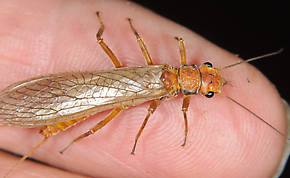 View 1 PicturesFly fishermen refer to this stonefly as one of "golden stones".
View 1 PicturesFly fishermen refer to this stonefly as one of "golden stones".
 View 1 PicturesFly fishermen refer to this stonefly as one of "golden stones".
View 1 PicturesFly fishermen refer to this stonefly as one of "golden stones".Collected November 30, 1999 from the Grande Rhonde River in Washington
Added to Troutnut.com by Bnewell on June 26, 2011
Added to Troutnut.com by Bnewell on June 26, 2011
Hesperoperla pacifica (Golden Stone) Stonefly Nymph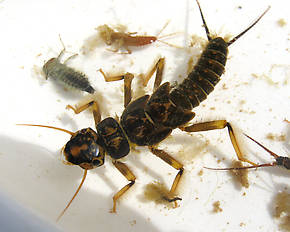 View 1 PicturesThis monster started to feed within a few minutes of sharing the inspection tray with its victims. This nymph is a voracious predator of small invertebrates and has even been noted for feeding on small fish and salmonid alevins. The niche it fills in fast water is equivalent to the Dragonfly nymphs that inhabit slower water.
View 1 PicturesThis monster started to feed within a few minutes of sharing the inspection tray with its victims. This nymph is a voracious predator of small invertebrates and has even been noted for feeding on small fish and salmonid alevins. The niche it fills in fast water is equivalent to the Dragonfly nymphs that inhabit slower water.
Hesperoperla pacifica nymphs are easily distinguished from other western perlids by the presence of anal gills (obfuscated by algae in the tray) in combination with an hour glass shaped pale mark on the front of their heads.
 View 1 PicturesThis monster started to feed within a few minutes of sharing the inspection tray with its victims. This nymph is a voracious predator of small invertebrates and has even been noted for feeding on small fish and salmonid alevins. The niche it fills in fast water is equivalent to the Dragonfly nymphs that inhabit slower water.
View 1 PicturesThis monster started to feed within a few minutes of sharing the inspection tray with its victims. This nymph is a voracious predator of small invertebrates and has even been noted for feeding on small fish and salmonid alevins. The niche it fills in fast water is equivalent to the Dragonfly nymphs that inhabit slower water.Hesperoperla pacifica nymphs are easily distinguished from other western perlids by the presence of anal gills (obfuscated by algae in the tray) in combination with an hour glass shaped pale mark on the front of their heads.
Collected March 22, 2013 from the Lower Yuba River in CA
Added to Troutnut.com by Entoman on April 4, 2013
Added to Troutnut.com by Entoman on April 4, 2013
Claassenia sabulosa (Golden Stone) Stonefly Nymph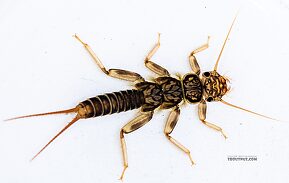 View 11 PicturesThis striking golden stonefly is the first of its species I've had the chance to photograph.
View 11 PicturesThis striking golden stonefly is the first of its species I've had the chance to photograph.
 View 11 PicturesThis striking golden stonefly is the first of its species I've had the chance to photograph.
View 11 PicturesThis striking golden stonefly is the first of its species I've had the chance to photograph.Collected April 12, 2021 from Holder Creek in Washington
Added to Troutnut.com by Troutnut on April 13, 2021
Added to Troutnut.com by Troutnut on April 13, 2021
Male Hesperoperla pacifica (Golden Stone) Stonefly Adult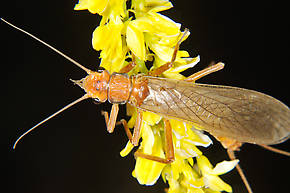 View 1 Pictures
View 1 Pictures
 View 1 Pictures
View 1 PicturesCollected June 17, 2011 from the Grande Rhonde River in Washington
Added to Troutnut.com by Bnewell on June 26, 2011
Added to Troutnut.com by Bnewell on June 26, 2011
Female Calineuria californica (Golden Stone) Stonefly Adult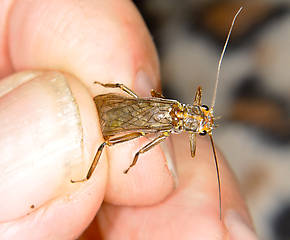 View 1 Pictures
View 1 Pictures
 View 1 Pictures
View 1 PicturesCollected June 17, 2011 from the Grande Rhonde River in Washington
Added to Troutnut.com by Bnewell on June 26, 2011
Added to Troutnut.com by Bnewell on June 26, 2011
Calineuria californica (Golden Stone) Stonefly Nymph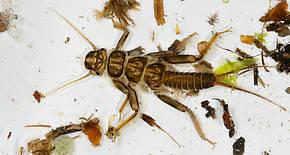 View 1 Pictures
View 1 Pictures
 View 1 Pictures
View 1 PicturesCollected August 9, 2011 from the Touchet River in Washington
Added to Troutnut.com by Bnewell on August 9, 2011
Added to Troutnut.com by Bnewell on August 9, 2011
Hesperoperla pacifica (Golden Stone) Stonefly Adult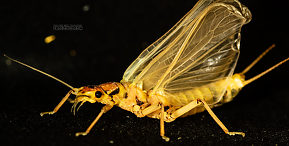 View 14 PicturesI collected this specimen as a nymph and had it in line to be photographed, but it emerged inside my holding container before I got the chance. However, I was able to get some interesting photos of the very freshly-emerged adult that really demonstrate how strikingly colors can change within a few short hours after emergence. The before-and-after pictures are combined here under a single specimen since they portray the same individual at different times within the same stage.
View 14 PicturesI collected this specimen as a nymph and had it in line to be photographed, but it emerged inside my holding container before I got the chance. However, I was able to get some interesting photos of the very freshly-emerged adult that really demonstrate how strikingly colors can change within a few short hours after emergence. The before-and-after pictures are combined here under a single specimen since they portray the same individual at different times within the same stage.
Based on the identification of another specimen from the same date/site, I'm calling this Hesperoperla pacifica.
 View 14 PicturesI collected this specimen as a nymph and had it in line to be photographed, but it emerged inside my holding container before I got the chance. However, I was able to get some interesting photos of the very freshly-emerged adult that really demonstrate how strikingly colors can change within a few short hours after emergence. The before-and-after pictures are combined here under a single specimen since they portray the same individual at different times within the same stage.
View 14 PicturesI collected this specimen as a nymph and had it in line to be photographed, but it emerged inside my holding container before I got the chance. However, I was able to get some interesting photos of the very freshly-emerged adult that really demonstrate how strikingly colors can change within a few short hours after emergence. The before-and-after pictures are combined here under a single specimen since they portray the same individual at different times within the same stage.Based on the identification of another specimen from the same date/site, I'm calling this Hesperoperla pacifica.
Collected July 2, 2019 from the Gallatin River in Montana
Added to Troutnut.com by Troutnut on July 18, 2019
Added to Troutnut.com by Troutnut on July 18, 2019
Hesperoperla pacifica (Golden Stone) Stonefly Nymph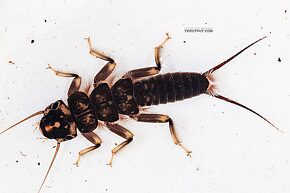 View 9 PicturesID notes from the microscope: The occiput (Occiput: The back of the head.) has a sinuate, irregularly spaced spinule row.
View 9 PicturesID notes from the microscope: The occiput (Occiput: The back of the head.) has a sinuate, irregularly spaced spinule row.
 View 9 PicturesID notes from the microscope: The occiput (Occiput: The back of the head.) has a sinuate, irregularly spaced spinule row.
View 9 PicturesID notes from the microscope: The occiput (Occiput: The back of the head.) has a sinuate, irregularly spaced spinule row.Collected August 3, 2020 from the East Fork Big Lost River in Idaho
Added to Troutnut.com by Troutnut on August 19, 2020
Added to Troutnut.com by Troutnut on August 19, 2020
Female Hesperoperla pacifica (Golden Stone) Stonefly Adult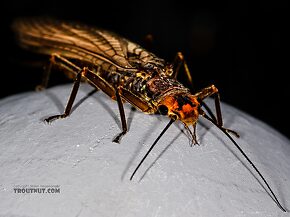 View 12 Pictures
View 12 Pictures
 View 12 Pictures
View 12 PicturesCollected August 1, 2020 from the Henry's Fork of the Snake River in Idaho
Added to Troutnut.com by Troutnut on August 17, 2020
Added to Troutnut.com by Troutnut on August 17, 2020
Hesperoperla pacifica (Golden Stone) Stonefly Nymph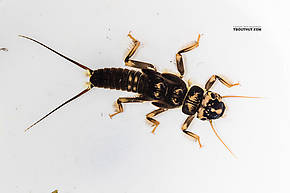 View 13 Pictures
View 13 Pictures
 View 13 Pictures
View 13 PicturesCollected March 19, 2019 from the South Fork Snoqualmie River in Washington
Added to Troutnut.com by Troutnut on June 14, 2019
Added to Troutnut.com by Troutnut on June 14, 2019
Top 10 Fly Hatches
Top Gift Shop Designs
Eat mayflies.
Top Insect Specimens
Miscellaneous Sites
Troutnut.com is copyright © 2004-2024 Jason
Neuswanger (email Jason). See my FAQ for information about use of my images.
 privacy policy
privacy policy
